Social networks take over a crucial part of our lives. Moreover, the app market is still growing. With the increasing use of smartphones all over the world, there have been opportunities for social networking with advanced features.
Consequently, many business owners can’t pass up the chance to be part of a thriving market and are thinking about new social media platforms development. Would you like to know how to create a social network app? Then read our guide to learn the details.
Table of Contents
Market trends and insights
Over the last year, the number of people that use social networks has grown by roughly 10%, and by the first days of July 2020, their total number has reached 3.96 billion.
- Thus, more than 50% of people worldwide use social networks for the first time. Besides, 99% of people use mobile apps for social network access.
- 68% of U.S. adults report that they use Facebook.
- 73% of marketers thought their social media marketing efforts were “efficient” for their companies.
- The best social media by the number of active users are Facebook, YouTube, WhatsApp, and Facebook Messenger.
- 49% of people say they rely on the recommendations of social media influencers when making a purchase decision.
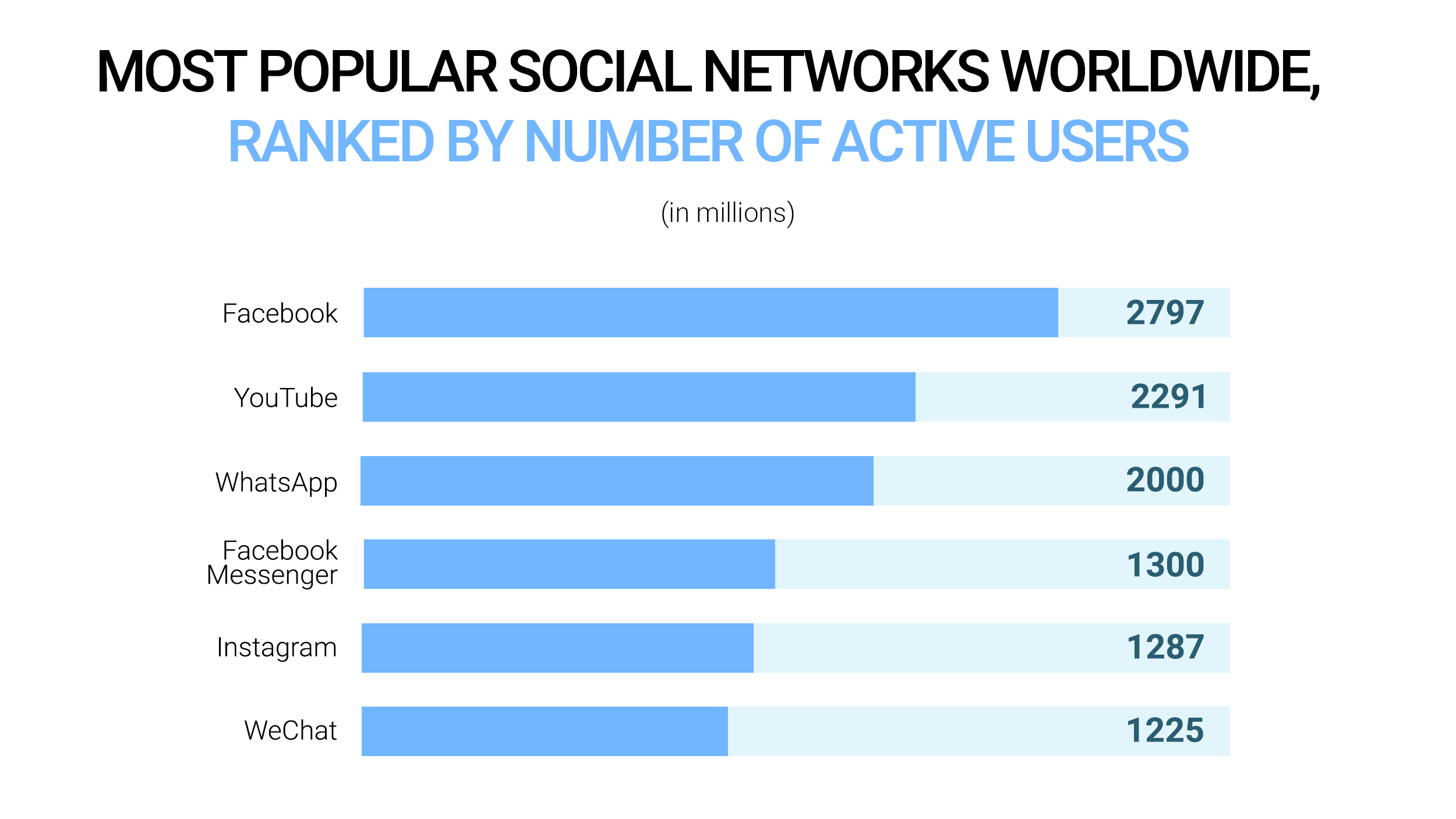
If you desire to build a social media app, then it’s critical to know its type. As it helps you to determine the competitors, audience, and offer future users suitable features.
So, let’s go deeper into the main types of social media apps.
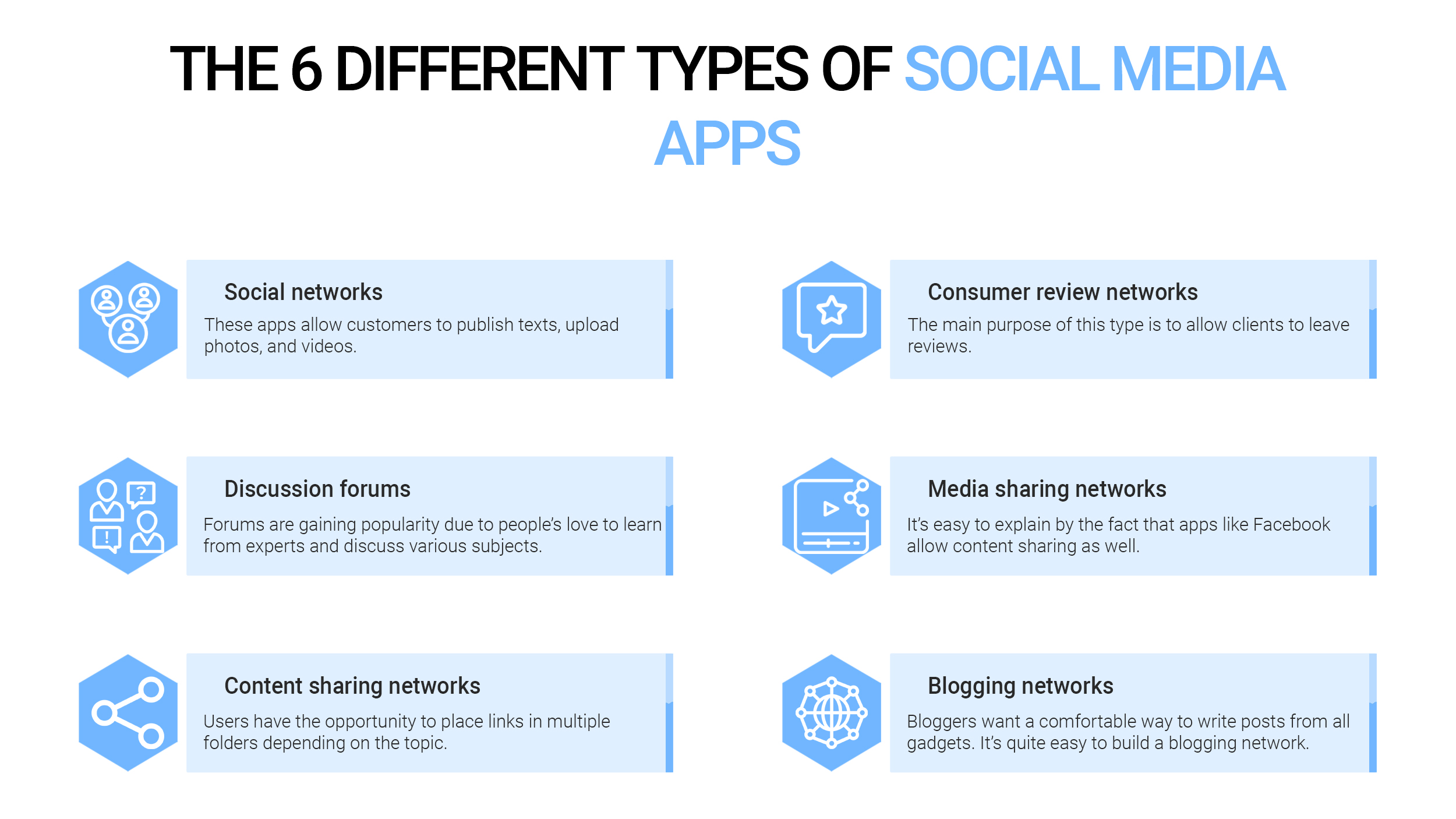
Such social media unites people with various purposes. I.e., LinkedIn helps to find work and build professional relationships, Facebook offers many thematic groups, etc. These apps allow customers to publish texts, upload photos, and videos.
☑️Consumer review networks
The main purpose of this type is to allow clients to leave reviews. These networks can attract new clients to a brand if feedbacks are good. Besides, entrepreneurs can receive customers’ reviews and change their items or services for the better. The best examples are Yelp, TripAdvisor.
☑️Discussion forums
Forums are gaining popularity due to people’s love to learn from experts and discuss various subjects. They allow finding the needed information. The best examples are Reddit, Quora.
☑️Media sharing networks
Today, media sharing networks are alike to social networks. It’s easy to explain by the fact that apps like Facebook allow content sharing as well. Besides, there are media-sharing networks like Instagram that focus on one certain type of content. Youtube, Instagram, and Snapchat are good examples.
☑️Content sharing networks
They allow saving links to various internet resources. Thus, users have the opportunity to place links in multiple folders depending on the topic. Pinterest, Flipboard are good examples of content-sharing networks.
☑️Blogging networks
Bloggers want a comfortable way to write posts from all gadgets. It’s quite easy to build a blogging network. The most famous examples are WordPress, Medium.
While social media apps typically target intersecting demographic groups, each has its unique value propositions and use cases. For example, TikTok fans are addicted to funny videos, and Instagram is addicted to a huge number of influencers. Despite the differences, some features are a must-have in any social media application.
Must-have features
Register
Users need to have several registration options. I.e., you can integrate parameters such as email and password, phone and password. To make the application more convenient, add the forgot password feature.

Depending on the type of social application, you have to allow users to create different profiles. It should include options such as connecting with other users and viewing their media or messages.
Newsfeed
Newsfeed helps people stay informed. All updates and new information from friends and communities are here. You can integrate this feature, as Instagram did. In this case, the news feed becomes the main screen of the social network application.
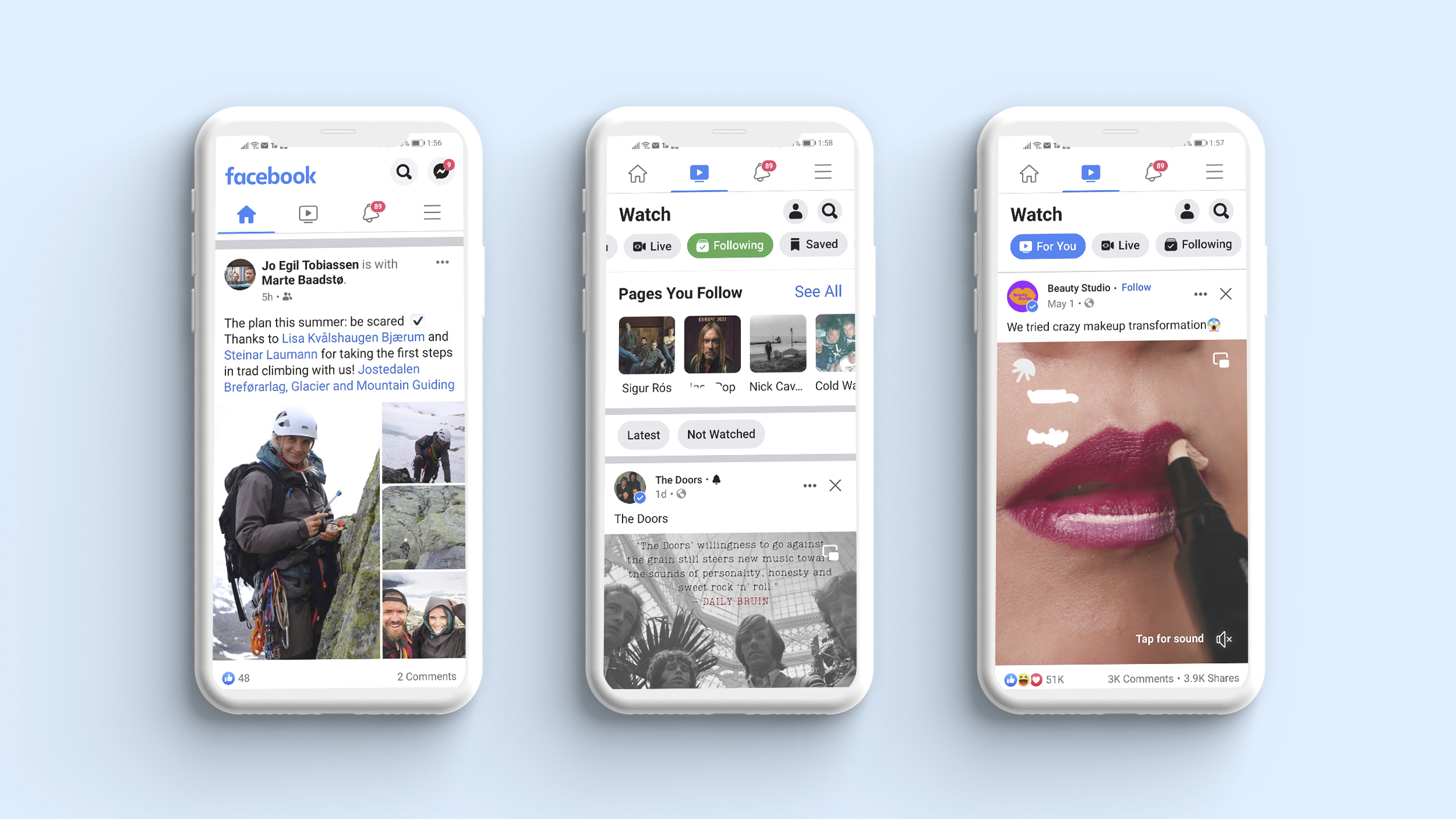
Users need a simple search bar to find friends or bloggers to follow. For example, make it possible to search by tags, usernames, and location.
Chat
Sending messages, photos or videos is a critical part of any social network. You can integrate group chats and channels so that people can communicate with two or more users.
Add post
Users should have the opportunity to add photos or videos or take pictures using the smartphone’s camera. After that, they can create a short description and post it on social media.
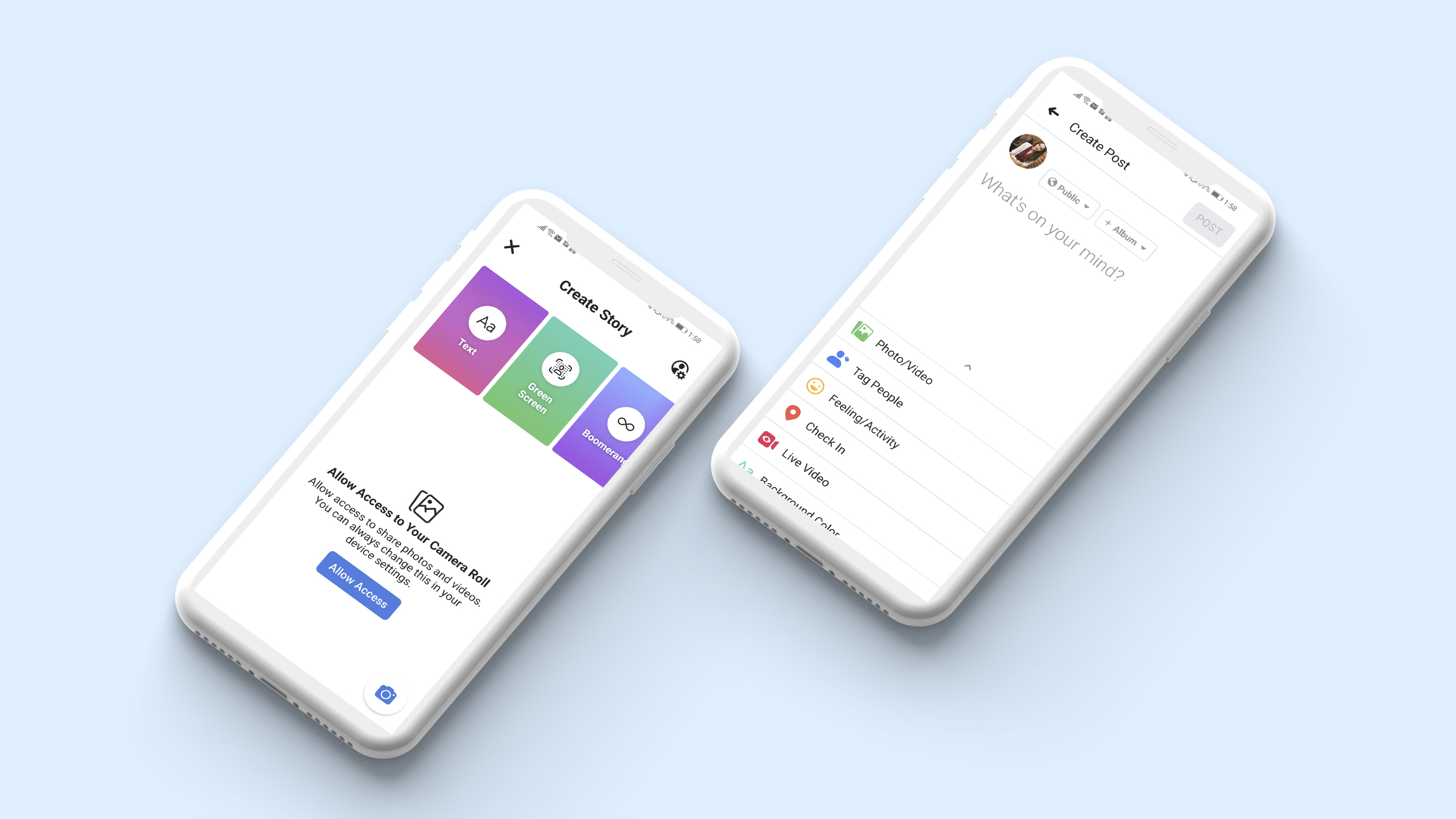
There are various push notifications that users can receive. I.e., a new post from the community they follow, a reaction or comment on their post, and more. Push notifications are good for user interaction.
Advanced features
✓Location-based content
Another great feature of the social media app is the provision of content based on the user’s location. The app analyzes the location and shows content posted by other users in the same location. Moreover, people can indicate their location in the post.
✓AR filters
Do you want to make your social media apps unique? Then integrate different filters and effects into the photos or videos. I.e., Instagram and Snapchat have loads of AR filters. Interesting ones help attract users to your app.
✓Editing
It’s good to invite users to edit their images in your social media app. For example, you can suggest options such as cropping and rotating images, removing unwanted objects, creating collages, and more.
✓Configurable privacy options
Some users like to share their information publicly, and some prefer to restrict access to their content only to people they know. The main feature of social media apps is the ability for users to manage their privacy settings.
✓Infinite scrolling
One of the biggest benefits of social media is that people discover new content. Take advantage of this desire and offer a limitless supply of the scrollable drug.
Requirements and technology stack
Now that we’ve talked about the development process, it’s time to discuss the technical side of building a social media app. We recommend making a cross-platform application to reduce costs. Moreover, it’s better to use up-to-date technologies for better result.
| Front-end | HTML5, CSS3, JavaScript, Angular, TypeScript |
| Back-end | NodeJS, AWS, MongoDB |
| Mobile applications | React Native |
| 3rd party services | Twilio, Facebook SDK, Web Sockets |
So, you’ve decided to build your social network. It’s not as tricky as it sounds, but not as easy as we would like it to be. The development includes several steps.
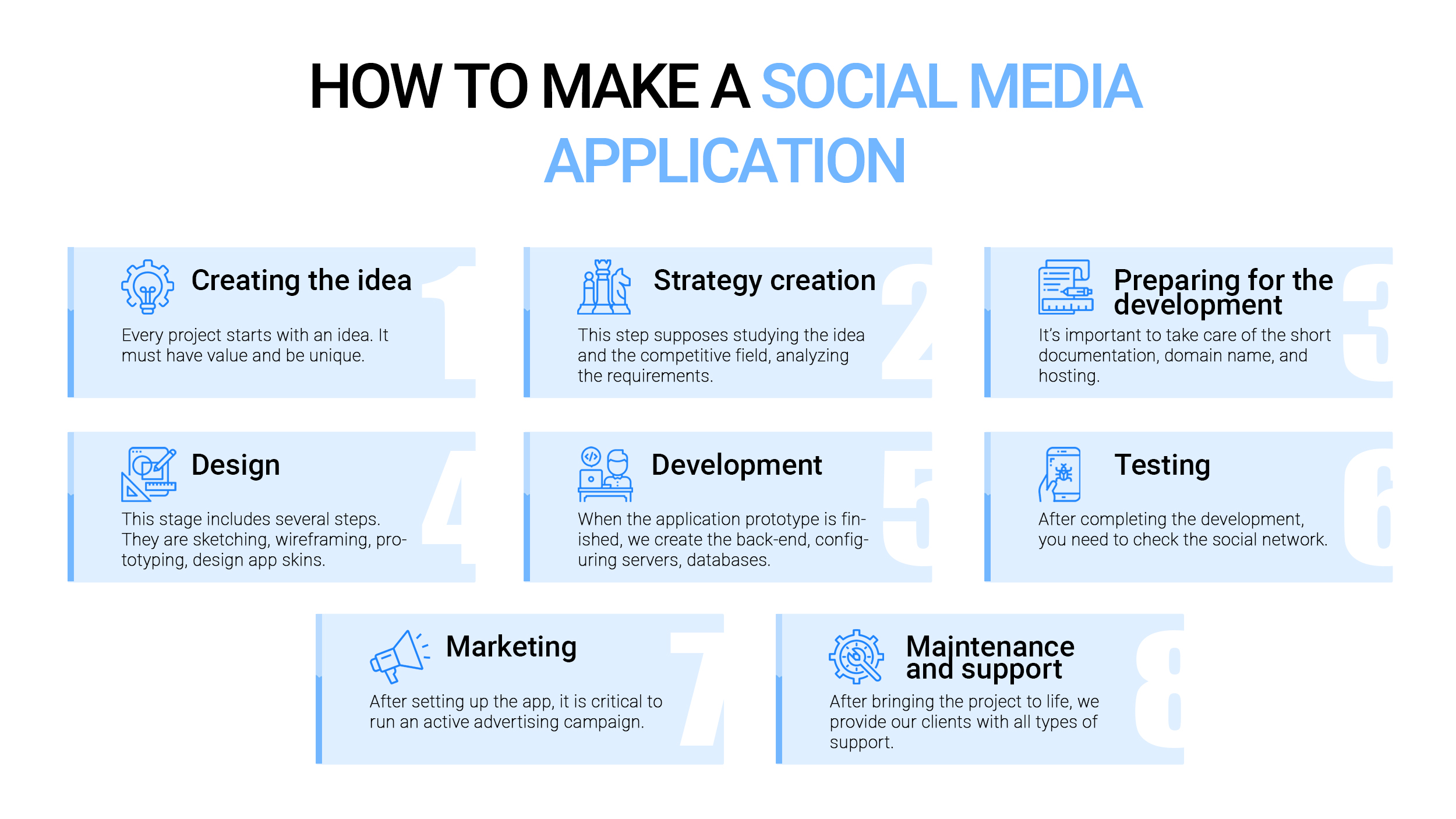
Every project starts with an idea. It must have value and be unique. Of course, you can copy the idea of existing social networks, but who needs one more Instagram. Make sure that your social network is interesting to users. Segmentation will help you with this. In any case, the idea should stand out from other similar projects. As cryptocurrency exchange platforms are gaining popularity in the world.
Step #2. Strategy creation
This step supposes studying the idea and the competitive field, analyzing the requirements, drawing up a portrait of the target audience, and setting the key performance indicators to be achieved.
Step #3. Preparing for the development
At this stage, it’s important to take care of the short documentation, domain name, and hosting. Short documentation is a small document that includes a list of functions for a future project. After considering the required functions. You should think about the name of the future social network. And then finally you can choose a powerful server.
Step #4. Design
This stage includes several steps. They are sketching, wireframing, prototyping, design app skins. Sketching helps to assess the logic of the future project, the number of screens, and the interaction between them. Wireframing gives a detailed view of the app and the experience that the end-user will have. Prototyping is a working model of a future application. Design app skins step supposes converting wireframes in the design.
Step #5. Development
When the application prototype is finished, we create the back-end, configuring servers, databases, APIs, and designing ideal storage solutions. The Code&Care team delivers a product that meets all technical requirements, user guides, and platform standards.
Step #6. Testing and launching a social network
After completing the development, you need to check the social network. As you can imagine, mistakes in registration/authorization or basic functions will have a very bad effect on the promotion of the social network. Users should enjoy the app.
Step #7. Marketing
After setting up the app, it is critical to run an active advertising campaign. You need to take an aggressive approach.
Step #8. Maintenance and support
After bringing the project to life, we provide our clients with all types of support.
Monetization strategies
Ultimately, a social media app needs to be well received by users and have the potential to make a profit. It means that it is critical to choose a business model that encourages long-term growth while maintaining income. Here are some popular business models commonly used in social media applications.
- Advertisements
Advertising is the most popular way to generate income for a social media platform. Many apps choose this option so that customers can use the app for free. For example, Instagram shows users relevant posts and stories in its news feed. As far as YouTube is concerned, it plays ads before playing the video.
- Premium feature
Many social media (e.g. YouTube, Linkedin) offer premium subscriptions to get some extra features. For example, LinkedIn offers premium options for job seekers. Users can see who has viewed their profile and access over 15,000 training courses to improve their skills and knowledge.
- Venture capital
Many major social media platforms start with funding from venture capitalists. The main examples are Twitter and Facebook. These companies have raised several million dollars in venture capital. The main goal is to monetize the social media app or sell it to larger businesses for profit.
How to Create Your Own Music Streaming App That Brings Clients
Social media app cost
The final price of a social media app development depends on the market rate in different regions. However, it usually involves the same amount of work involved in creating the back end and the application’s front end.
Commonly, it takes over 1000 hours to create an MVP on one platform. The final cost of developing an app depends on where the developers are based.
Tips and tricks
Business analysis requires sticking to the metrics that track engagement and help to make effective solutions. The set of instruments may be varied depending on the type and goal of the app. But here is the list of the most critical ones:
☑️CPI & CAC
Cost Per Install (CPI) is a metric calculated by tracking installs of people that came from ads. It is counted by dividing advertising costs by the number of app installs.
Customer Acquisition Cost (CAC) is the total cost of all marketing efforts that are needed to acquire a new customer.
☑️User activation
Active users in comparison to downloads. Activation actions/parameters are customized for each app.
☑️User retention and churn rate
In the simplest sense, user retention is keeping people coming back to your application.
The churn rate shows the number of users who have stopped using the social media mobile app. The less it is, the better.
☑️User engagement
Several target actions are taken in the app. The two main ones are session length and interval. Session length demonstrates the time between the user who entered the app and left it. Session interval shows the time between two sessions.
☑️Traction
Simply put, traction shows patterns of the month-to-month growth of customers.
☑️Burn rate
This metric shows how many resources are required at the disposal that is needed to plan growth and fundraising in the future.
The final words
Social media app creation is difficult for several reasons. First, the social media market has long been taken over by giants such as Facebook, Twitter, Instagram, and YouTube. Second, the app needs an audience. This means that you need to invest a huge resource in researching the needs of your future users and developing a strategy to attract them and stimulate their activity on your platform.
The good news is that it’s not just global social platforms with millions of users that generate good profits. Thematic niche social networks give users more than the all-encompassing giants.
Niche platforms are tailored to the needs, capabilities, and interests of their target audience. Well-designed niche platforms generate more user trust, easily go viral, and often show much higher audience engagement than regular social media platforms.
✔Related articles:
How to Make Your Own Grocery Delivery App and Become The Leader of The Market
E-learning application development: Process, Features, and Cost
How to Make an App like Clubhouse: Features, Tech Stack, Cost
How to Build a Rideshare App: Types, Features, Cost and Challenges
















Popular
Latest